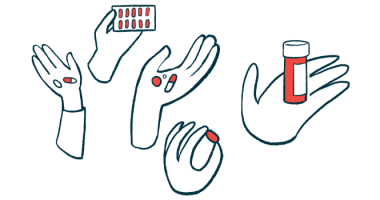Gene Editing Restored Dystrophin Levels in Dog Model of Duchenne MD, Study Reports
by |

Using the gene editing process CRISPR/Cas9 enabled a marked restoration of dystrophin production in various muscles of dogs with Duchenne muscular dystrophy (DMD).
The study with that finding, “Gene editing restores dystrophin expression in a canine model of Duchenne muscular dystrophy,” was published in the journal Science.
Thousands of mutations in the gene coding for the protein dystrophin – which plays a key role in strengthening muscle fibers and protecting them from injury – have been associated with the development of DMD. Many of these mutations are located in a DMD gene region spanning exons 45 and 50. Exons are the bits of DNA that contain the information to generate proteins.
Therapies designed to “skip” exon 51, such as Exondys 51 (eteplisren, by Sarepta Therapeutics), enable the production of a shorter, but functional, version of dystrophin and could benefit about 13 percent of DMD patients.
In mice, gene editing with CRISPR/Cas9 was able to restore dystrophin levels in muscle cells derived from human stem cells, but the effectiveness and safety of gene editing still needs to be demonstrated in large animals.
The mutation carried by the deltaE50-MD dog model of DMD consists in the loss of exon 50 and can be corrected with exon 51 skipping, which is a valuable research tool because the animals share many of the features of DMD patients, including muscle weakness, atrophy and fibrosis (scarring).
The team from University of Texas Southwestern Medical Center and the Royal Veterinary College, in London, England, used CRISPR/Cas9 to target a DMD region next to the splice acceptor site (one of the specific gene regions required for splicing, thereby deleting) of exon 51. This site differs by only one nucleotide (the building blocks of DNA and RNA) between dogs and humans.
To deliver their gene editing strategy to the dogs’ skeletal muscle and heart tissue, the researchers used a modified, harmless virus called AAV9, which they injected into the hindlimb’s cranial tibialis muscles in two one-month-old dogs.
RNA analysis of the injected dogs showed that deleting exon 51 restored the gene’s reading frame. This means that conversion of DNA to RNA was achieved beyond the gene’s exon 52. Also, the team’s gene editing approach was specific, in that it did not affect other genetic targets.
Six weeks after injection, the investigators observed that the dogs’ cranial tibialis muscles had widespread production of dystrophin, which was restored to nearly 60% of control levels. This contrasted to only 2% on average in the non-injected side in each animal. Also, injected muscles appeared to be normalized with less cell death in fibers, as well as reduced inflammation and fibrosis.
Injected muscles also showed decreased amounts of a marker of muscle regeneration (dMHC) and increased assembly of a complex called dystrophin-associated glycoprotein complex (DGC), which is destabilized in animal models and patients with DMD. This complex links the cytoskeleton — a structure key to maintaining the cells’ shape and organization — and the extracellular matrix, which provides structural and biochemical support to cells.
Then, the team used two AAV doses to analyze the strategy’s ability to rescue dystrophin production after intravenous (systemic) delivery in two more dogs. Analysis after eight weeks revealed dystrophin expression ranging from 3 to 90% of normal in a broad range of muscles. In the cardiac muscle, dystrophin levels reached 92% of normal with the higher dose. Blood tests revealed no differences between all used dogs.
“Our results demonstrate the efficacy of single cut genome editing for restoration of dystrophin expression in a large animal model of DMD,” the scientists wrote. “These large animal data support the concept that, with further development, gene editing approaches may prove clinically useful for the treatment of DMD,” they added.
However, they cautioned that the study is preliminary, used a small number of animals and performed the analysis in a short timeframe. Future long-term studies should use more animals and also further assess the possible unspecific genetic changes induced with this approach, they advised.
Of note, four of the study’s authors are consultants for Exonics Therapeutics. Also, two authors are co-inventors on a patent application related to this gene-editing strategy.







